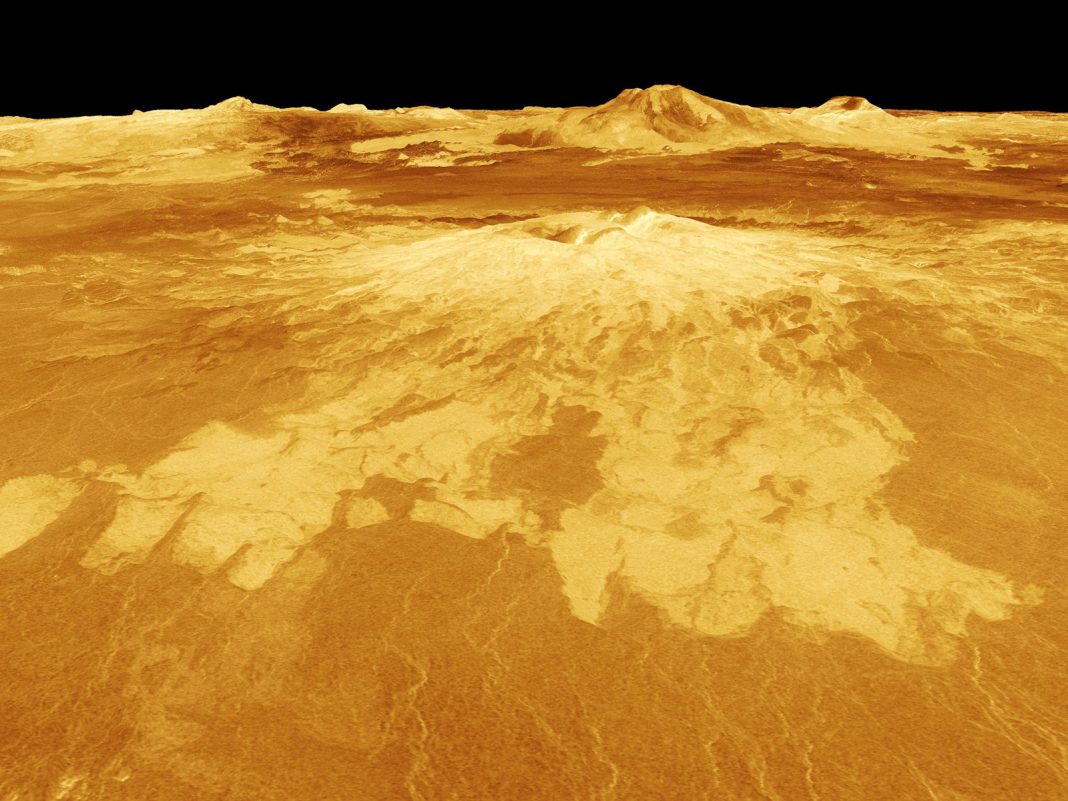Last fall, researchers said the presence of phosphine in the planet’s atmosphere could indicate life. But a new study says there could be a geological explanation.
VENUS IS OFTEN called Earth’s sister planet, a neighboring twin of similar density and size. But the resemblance stops there. As the hottest planet in our solar system, the choking Venusian atmosphere is full of heat-trapping carbon dioxide and clouds thick with sulfuric acid that shroud its dry, volcanic terrain.
So it’s one of the last places anyone might think to look for life beyond our planet.
That’s why it came as such a shock last September when a group of scientists, led by Jane Greaves of Cardiff University, announced that they’d found a possible sign of alien life in the Venusian atmosphere. In the study, published in Nature Astronomy, they reported the detection of a colorless, toxic gas called phosphine in the planet’s clouds and concluded that no known chemical or geological processes could explain its presence. Phosphine could indicate life, they argued, noting recent work by astrophysicist Clara Sousa-Silva of MIT who suggests the gas could be a biosignature. On Earth, phosphine is often found in places that host anaerobic life, including lakes, marshes, paddy fields, and in the sludge of landfills.
But when the news reached Jonathan Lunine, an astronomer at Cornell University, he and graduate student Ngoc Truong were immediately skeptical. “It’s problematic to invoke phosphine as a biosignature on Venus, simply because the environment on Venus is totally different from the environment on Earth,” says Truong. Even on our own planet, he says, there is some confusion as to whether phosphine is associated with life, and he believes that this should be confirmed before extrapolating these observations to environments so unlike our own.
Truong and Lunine weren’t alone in their doubts. After the phosphine announcement, the internet exploded with discussions about the discovery. Scientists weighed in on Twitter threads, argued on Facebook posts, and flocked to arXiv.org, a preprint server for scientific research, to lay out other theories for what nonbiological processes might be producing the phosphine.
Truong, who until that point had been studying the oceans on Saturn’s moons, convinced Lunine that they needed to further explore one potential source of phosphine in particular: volcanoes. Their research culminated in a new study published Monday in the journal Proceedings of the National Academy of Sciences. In it, Truong and Lunine paint a picture of how phosphine might make it into Venus’ atmosphere. Trace amounts of phosphides (negatively charged phosphorus ions attached to metals like iron) found deep in the mantle of Venus could be pulled up to the surface by volcanic activity. When the volcanoes erupt, these phosphides could be thrust into the atmosphere and chemically react with sulfuric acid in the clouds to form phosphine.
“Our study only suggests a road map to assessing the level of volcanic eruptions” on Venus, Truong says. Two conditions are needed for this to be a viable explanation. First, the planet must be volcanically active. (While thousands of volcanoes have been spotted in radar images of Venus, scientists lack the data to confirm recent eruptions, since so far, landers can only withstand the raging heat and crushing pressure of the Venusian surface for about an hour.) “And not just active in the sense of ‘Hawaiian-style’ volcanism,” Lunine says, which typically produces lava flows without much explosivity. Explosive volcanism is key, because there needs to be a mechanism for the phosphides to be ejected into the atmosphere.ADVERTISEMENT
Second, scientists would need to verify that the phosphine is actually there—and that’s currently a huge point of contention. Without this proof, Lunine says, the volcano theory “becomes an empty postulate rather than a hypothesis.”
FEATURED VIDEOAstronomer Explains How SETI Searches for AliensMost Popular
- SCIENCEBe Very Careful Where You Build That SeawallMATT SIMON
- SCIENCEA Massive Water Recycling Proposal Could Help Ease DroughtMATT SIMON
- GEARHow Lego Perfected the Recycled Plastic BrickJEREMY WHITE, WIRED UK
- GEARThe 9 Best Turntables for Your Vinyl CollectionPARKER HALL
ADVERTISEMENThttps://b708fe9a5356a9e2c3236c24a0ef2e89.safeframe.googlesyndication.com/safeframe/1-0-38/html/container.html
The original paper by Greaves’ team used data collected by the James Clerk Maxwell Telescope and the Atacama Large Millimetre/Submillimetre Array (ALMA), and it reported that they’d detected about 20 parts per billion of excess phosphine in the Venusian air. But in subsequent months, the discovery of a calibration error in ALMA’s data led the authors to decrease that value to a range of one to five parts per billion. (Other researchers not involved in the work, who did their own analysis of the ALMA data, failed to find evidence of phosphine at all.) By mid-November, a note was added to the original study: “The authors have informed the editors of Nature Astronomy about an error in the original processing of the ALMA Observatory data underlying the work in this article, and that recalibration of the data has had an impact on the conclusions that can be drawn.”
(Greaves and Sousa-Silva did not respond to requests for comment for this story.)
But the volcano hypothesis, too, has its critics. On the same day in 2020 when Greaves’ team published their paper, MIT astrobiologist Janusz Petkowski uploaded a hefty preprint to arXiv, coauthored by a subset of the researchers who had also contributed to the Greaves report, arguing that the phosphine’s source could be biological. In 103 pages, via an extensive analysis of known gas, geochemical, and photochemical reactions, they ruled out the genesis of phosphine by conventional methods—including volcanic activity. Their conclusion: The phosphine must come from some new and unknown process or from microbial life in Venus’ clouds.
Since then, the authors have refined their arguments and addressed concerns like the recalibrated ALMA data; on Monday, a peer-reviewed version of the paper was accepted to Astrobiology, Special Collection: Venus. Late on Tuesday night, following the publication of the Cornell volcano study, Petkowski and his team decided to publicly post the new version of the paper on arXiv (with a corresponding note that explicitly calls Truong and Lunine’s volcano hypothesis unlikely). Notably, the updated version of the document includes even more detailed calculations—it’s now 126 pages long—using a conservative value of one part per billion of phosphine in Venus’ atmosphere. But even with the smaller amount, Petkowski and his team still don’t rule out the possibility of life, because they failed to find any known abiotic process that would accurately describe their observation of phosphine.
“We just do not think that deep-mantle volcanism is a reasonable source for phosphine on Venus,” Petkowski says. In the paper, they argue that it isn’t clear how phosphides could make it from the interior of Venus to the surface unchanged, and that the scale and frequency of volcanic eruptions needed to spew enough of these phosphides into the air, where they can react with sulfuric acid to produce phosphine, is unlikely. Petkowski’s team also wrote that the atmospheric concentration of sulfuric acid likely wouldn’t produce phosphine at all. Instead, it would cause a different chemical reaction with the phosphide called oxidation. (Truong and Lunine disagree; in their paper, they say that oxidation would be limited by the lack of water in Venus’ clouds.)
Sukrit Ranjan, a planetary photochemist at Northwestern University who worked on the original phosphine discovery as well as the follow-up study helmed by Petkowski, says that while his team agrees with “the guts of the calculation” described in Truong and Lunine’s paper, the disagreement lies in which assumptions can be realistically made when modeling volcanic processes on Venus that could produce phosphine in the atmosphere. “When there was ambiguity, we tried to make it as easy as possible for an abiotic explanation of phosphine,” he says of his team’s latest paper, but their analysis kept falling short.https://b708fe9a5356a9e2c3236c24a0ef2e89.safeframe.googlesyndication.com/safeframe/1-0-38/html/container.htmlMost Popular
ADVERTISEMENThttps://b708fe9a5356a9e2c3236c24a0ef2e89.safeframe.googlesyndication.com/safeframe/1-0-38/html/container.html
Ranjan stresses, however, that in the 2020 preprint, as well as the latest peer-reviewed version, his team doesn’t exactly rule out volcanic activity as a possibility—they only claim that it cannot be explained with known geochemical processes. “Even life is not a natural explanation for phosphine in the atmosphere,” he says, because life as we know it could not possibly survive in the acidic environment of Venus’ clouds. But evolution could have developed tricks elsewhere that it hasn’t on Earth, so the universe may surprise us: “Habitability is a frontier to be explored,” he says.
Petkowski welcomes the hearty debate between scientists. “We are not afraid to be wrong,” he says. And even if further scrutiny of the data rules out the presence of any phosphine at all, Petkowski says it wouldn’t completely rule out the possibility of life for him. “The story is not over,” he says.
Upcoming NASA missions, planned long before scientists saw possible hints of life, will help solve the mystery of phosphine in the atmosphere. VERITAS, set to launch in 2028, is a spacecraft that will map out the surface and look for the presence of deep underground water spewed out as vapor by active volcanoes. Around the same time, a spherical probe named DAVINCI+ will plunge through the toxic atmosphere and measure the composition of the Venusian clouds, which could confirm or rule out the existence of phosphine.
Suzanne Smrekar, the NASA geophysicist leading the VERITAS mission, says that the possibility of life on Venus is exciting—and a wake-up call. “It’s going to take a very long time to say we believe there is life,” she says. “But it’s a rallying cry to investigate this area of science much more definitively.”
Truong and Lunine, who began working on the volcano hypothesis before NASA selected the discovery missions, are standing by their assertion that it can plausibly explain the presence of phosphine, and they are eager to see what comes next. “I hope this increases interest in Venus as a planet,” Lunine says. But he feels that it shouldn’t have taken a debate about life to spark so much curiosity about Venus. Even without life, we should want to get to know our planetary sibling, which is so similar to our home in many ways, “and yet it seems so different geologically,” he says. “This is just another reason to think of Venus as an interesting target for exploration.”











